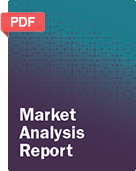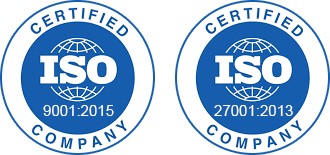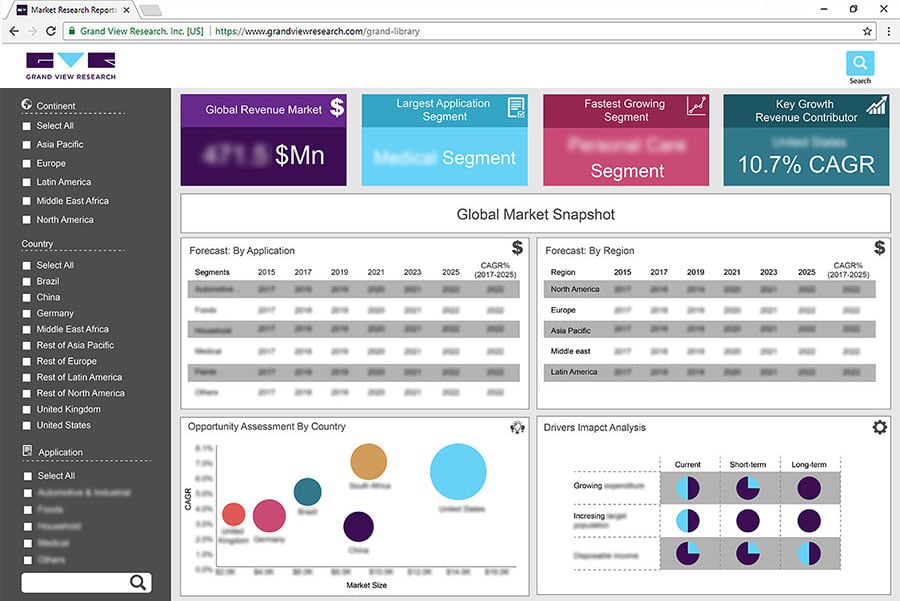
Specialty Fuel Additives Market Size, Share & Trends Analysis Report By Product (Deposit Control Additives, Cetane Improvers), By Application (Gasoline, Diesel, Aviation Turbine Fuel), By Region, And Segment Forecasts, 2023 - 2030
- Report ID: 978-1-68038-007-1
- Number of Report Pages: 140
- Format: PDF, Horizon Databook
- Historical Range: 2018 - 2021
- Forecast Period: 2023 - 2030
- Industry: Bulk Chemicals
Market Segmentation
- Global specialty fuel additives Product Outlook (Volume, Tons; Revenue, USD Million, 2023 - 2030)
- Deposit Control
- Cetane Improvers
- Antioxidants
- Lubricity Improvers
- Cold flow Improvers
- Corrosion Inhibitors
- Other
- Global specialty fuel additives Application Outlook (Volume, Tons; Revenue, USD Million, 2023 - 2030)
- Gasoline
- Diesel
- Other
- Aviation turbine fuel
- Others
- Global specialty fuel additives Regional Outlook (Volume, Tons; Revenue, USD Million, 2019- 2030)
- North America
- North America specialty fuel additives Market by Product
- Deposit Control
- Cetane Improvers
- Antioxidants
- Lubricity Improvers
- Cold flow Improvers
- Corrosion Inhibitors
- Other
- North America specialty fuel additives Market by Application
- Gasoline
- Diesel
- Other
- Aviation turbine fuel
- Others
- U.S.
- U.S. specialty fuel additives Market by Product
- Deposit Control
- Cetane Improvers
- Antioxidants
- Lubricity Improvers
- Cold flow Improvers
- Corrosion Inhibitors
- Other
- U.S. specialty fuel additives Market by Application
- Gasoline
- Diesel
- Other
- Aviation turbine fuel
- Others
- U.S. specialty fuel additives Market by Product
- Canada
- Canada specialty fuel additives Market by Product
- Deposit Control
- Cetane Improvers
- Antioxidants
- Lubricity Improvers
- Cold flow Improvers
- Corrosion Inhibitors
- Other
- Canada specialty fuel additives Market by Application
- Gasoline
- Diesel
- Other
- Aviation turbine fuel
- Others
- Canada specialty fuel additives Market by Product
- North America specialty fuel additives Market by Product
- Europe
- Europe specialty fuel additives Market by Product
- Deposit Control
- Cetane Improvers
- Antioxidants
- Lubricity Improvers
- Cold flow Improvers
- Corrosion Inhibitors
- Other
- Europe specialty fuel additives Market by Application
- Gasoline
- Diesel
- Other
- Aviation turbine fuel
- Others
- Germany
- Germany specialty fuel additives Market by Product
- Deposit Control
- Cetane Improvers
- Antioxidants
- Lubricity Improvers
- Cold flow Improvers
- Corrosion Inhibitors
- Other
- Germany specialty fuel additives Market by Application
- Gasoline
- Diesel
- Other
- Aviation turbine fuel
- Others
- Germany specialty fuel additives Market by Product
- France
- France specialty fuel additives Market by Product
- Deposit Control
- Cetane Improvers
- Antioxidants
- Lubricity Improvers
- Cold flow Improvers
- Corrosion Inhibitors
- Other
- France specialty fuel additives Market by Application
- Gasoline
- Diesel
- Other
- Aviation turbine fuel
- Others
- France specialty fuel additives Market by Product
- U.K.
- U.K. specialty fuel additives Market by Product
- Deposit Control
- Cetane Improvers
- Antioxidants
- Lubricity Improvers
- Cold flow Improvers
- Corrosion Inhibitors
- Other
- U.K. specialty fuel additives Market by Application
- Gasoline
- Diesel
- Other
- Aviation turbine fuel
- Others
- U.K. specialty fuel additives Market by Product
- Europe specialty fuel additives Market by Product
- Asia Pacific
- Asia Pacific specialty fuel additives Market by Product
- Deposit Control
- Cetane Improvers
- Antioxidants
- Lubricity Improvers
- Cold flow Improvers
- Corrosion Inhibitors
- Other
- Asia Pacific specialty fuel additives Market by Application
- Gasoline
- Diesel
- Other
- Aviation turbine fuel
- Others
- China
- China specialty fuel additives Market by Product
- Deposit Control
- Cetane Improvers
- Antioxidants
- Lubricity Improvers
- Cold flow Improvers
- Corrosion Inhibitors
- Other
- China specialty fuel additives Market by Application
- Gasoline
- Diesel
- Other
- Aviation turbine fuel
- Others
- China specialty fuel additives Market by Product
- India
- India specialty fuel additives Market by Product
- Deposit Control
- Cetane Improvers
- Antioxidants
- Lubricity Improvers
- Cold flow Improvers
- Corrosion Inhibitors
- Other
- India specialty fuel additives Market by Application
- Gasoline
- Diesel
- Other
- Aviation turbine fuel
- Others
- India specialty fuel additives Market by Product
- Japan
- Japan specialty fuel additives Market by Product
- Deposit Control
- Cetane Improvers
- Antioxidants
- Lubricity Improvers
- Cold flow Improvers
- Corrosion Inhibitors
- Other
- Japan specialty fuel additives Market by Application
- Gasoline
- Diesel
- Other
- Aviation turbine fuel
- Others
- Japan specialty fuel additives Market by Product
- Asia Pacific specialty fuel additives Market by Product
- Central & South America
- Central & South America specialty fuel additives Market by Product
- Deposit Control
- Cetane Improvers
- Antioxidants
- Lubricity Improvers
- Cold flow Improvers
- Corrosion Inhibitors
- Other
- Central & South America specialty fuel additives Market by Application
- Gasoline
- Diesel
- Other
- Aviation turbine fuel
- Others
- Brazil
- Brazil specialty fuel additives Market by Product
- Deposit Control
- Cetane Improvers
- Antioxidants
- Lubricity Improvers
- Cold flow Improvers
- Corrosion Inhibitors
- Other
- Brazil specialty fuel additives Market by Application
- Gasoline
- Diesel
- Other
- Aviation turbine fuel
- Others
- Brazil specialty fuel additives Market by Product
- Central & South America specialty fuel additives Market by Product
- Middle East & Africa
- Middle East & Africa specialty fuel additives Market by Product
- Deposit Control
- Cetane Improvers
- Antioxidants
- Lubricity Improvers
- Cold flow Improvers
- Corrosion Inhibitors
- Other
- Middle East & Africa specialty fuel additives Market by Application
- Gasoline
- Diesel
- Other
- Aviation turbine fuel
- Others
- Saudi Arabia
- Saudi Arabia specialty fuel additives Market by Product
- Deposit Control
- Cetane Improvers
- Antioxidants
- Lubricity Improvers
- Cold flow Improvers
- Corrosion Inhibitors
- Other
- Saudi Arabia Africa specialty fuel additives Market by Application
- Gasoline
- Diesel
- Other
- Aviation turbine fuel
- Saudi Arabia specialty fuel additives Market by Product
- Middle East & Africa specialty fuel additives Market by Product
- North America
Specialty Fuel Additives Market Dynamics
Driver: Strict environmental regulations
Emission standards limit pollutants released by automobiles, aircrafts, and diesel generators into the environment. The standards are set by regulatory bodies such as the EPA in the U.S.; European Union; and the Central Pollution Control Board in India among others to control the environmental emission of pollutants. These standards aim to control the levels of conventional pollutants such as nitrogen oxide, sulfur oxide, carbon dioxide, lead, particle pollution, and carbon monoxide released into the air. Deposit control additives such as PIB Amine and PIB Phenol Mannich Amine act as detergents and keep the entire engine fuel system clean starting from the fuel tank to the combustion chamber. The additives prevent the formation of deposits, especially on the intake valve and fuel injectors thereby increasing the air and fuel flow through the engine, enhancing performance, efficiency, and reducing emissions. The Euro VI standards became effective from January 2013 in the European Union countries. Each amendment in these acts introduce newer standards with reduced emission limits to prevent environmental hazards. The above-mentioned emission standards are applicable to vehicles with a useful life of 100, 000 miles in the U.S. Fuel additives are primarily used to control harmful emissions and enhance fuel efficiency. Fuel additives such as deposit control agents, cetane improvers, emission reducers, lubricity improvers, and antioxidants have unique functions and together facilitate to reduce pollutant release and improve fuel performance. The addition of fuel additives helps in meeting the standards of regulatory bodies by controlling combustion rate and reducing harmful emissions. Thus, it acts as a feasible option for fuel producers and consumers to control the emission of various pollutants including carbon monoxide, nitrogen oxide, and others.
Driver: Increasing consumer awareness
There are a number of benefits associated with the use of fuel additives. For instance, fuel additives reduce the risk of static discharge, thus preventing fire and explosion in the engine. Fuel additives also protect the fuel pipelines, fuel tanks, and other equipment from corrosion, thus reducing the massive maintenance cost. They also enhance the performance as well as increase fuel economy of the engine, which in turns reduces emission and optimizes combustion to keep the fuel system clean. Thus, growing awareness among end-use consumers regarding the benefits associated with the use of additives is expected to drive the market growth over the forecast period.
Importance of Cetane Cetane improvers are the most commonly used fuel additives. The additives help in reducing the ignition delays to make the fuel ignition more viable, making the engine more efficient and thus reducing exhaust emission. Their rating carries a dimension of quality of the fuel, which is the lag of time between fuel ignition and actual combustion. Shorter time lag accounts for higher cetane rating. Diesel engines work better on a cetane rating and range between 40 to 55. Although higher the number, shorter will be the ignition lag and hence more effective combustion cycle, which results in smoother engine response.
Impact of external factors: - This is one of the added advantages to the fuel additives as they do not get influenced by external factors such as variations in temperature, water, and humidity in terms their usage which ensures their stability around the globe. However, external factors are affecting diesel additives. Therefore, the same cannot be said about them.
Restraint: Growing demand for alternative fuel (autogas/CNG)
Major applications of fuel additives include diesel, gasoline, ATF, heating fuel, and marine fuel. The fuels find application in the transportation industry for use in automobiles, railways, and jets. Conventional transportation fuels, such as gasoline and diesel, release harmful emissions when ignited. Moreover, governments globally are moving toward developing and commercializing other fuels to reduce reliance on conventional fuels due to depleting crude oil reserves. Therefore, the global demand for alternative fuels such as Liquefied Petroleum Gas (LPG) and Compressed Natural Gas (CNG) is on a rise. However, the growing demand for such alternatives is expected to hamper the growth of gasoline, diesel, and other conventional transportation fuels over the forecast period. Globally, Automotive Liquefied Petroleum Gas, also known as autogas, is used as a fuel in many countries. Autogas has high energy content, burns easily in comparison to other energy sources or fuels, and offers various functional benefits such as low maintenance, less soot formation, and reduced frequency of changing the spark plug and oil. The consumption of autogas has rapidly increased over the last few years, primarily due to its environmental benefits over conventional fuels. Governments of countries such as the U.S., Algeria, Australia, and others have been promoting the use of autogas through various initiatives. In the U.S., fueling equipment for LPG, E85, or diesel fuel blended with biodiesel installed from January 2006 to December 2013 are eligible for 30% tax credits. Alternative fuels such as LPG and CNG require fuel additives such as H2S scavengers that are engineered specifically for gas engines. Unlike fuel additives, these additives are primarily composed of petroleum hydrocarbons. They help in lubricating the valves, clean injectors, and remove deposits leading to increased engine life. Hence, the growing demand for LPG and CNG is expected to hinder the fuel additives market used in gasoline, diesel, and other transportation fuels.
What Does This Report Include?
This section will provide insights into the contents included in this specialty fuel additives market report and help gain clarity on the structure of the report to assist readers in navigating smoothly.
Specialty fuel additives market qualitative analysis
-
Industry overview
-
Industry trends
-
Market drivers and restraints
-
Market size
-
Growth prospects
-
Porter’s analysis
-
PESTEL analysis
-
Key market opportunities prioritized
-
Competitive landscape
-
Company overview
-
Financial performance
-
Product benchmarking
-
Latest strategic developments
-
Specialty fuel additives market quantitative analysis
-
Market size, estimates, and forecast from 2023 to 2030
-
Market estimates and forecast for product segments up to 2030
-
Regional market size and forecast for product segments up to 2030
-
Market estimates and forecast for application segments up to 2030
-
Regional market size and forecast for application segments up to 2030
-
Company financial performance



